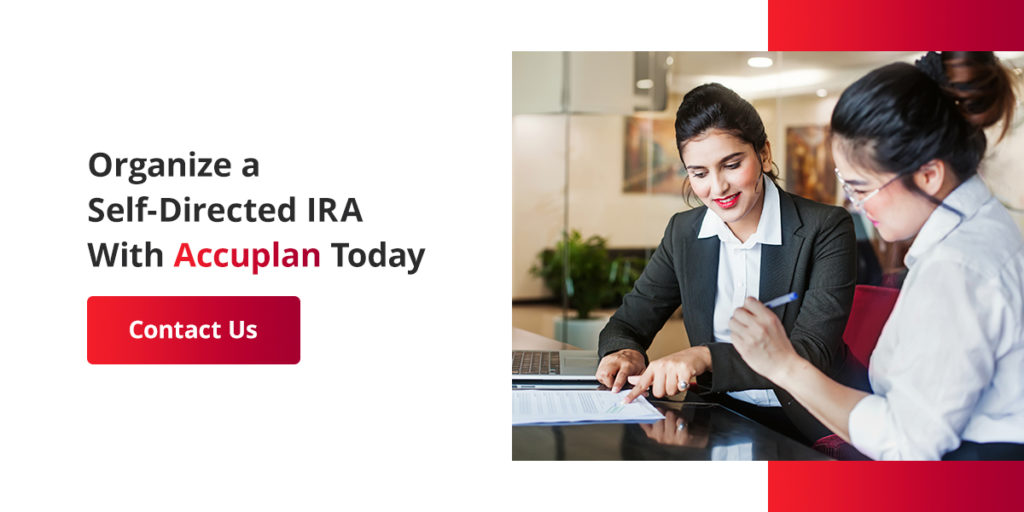
Self-directed IRAs have been around for a long time, and their increasing popularity has grown over time, especially among those who like a lot more control of their financial future. A self-directed IRA provides diversification of assets for everyone from the average Joe to investors looking to expand beyond stocks, bonds and treasuries.
A self-directed IRA involves a custodian holding your money in the account and making investments for you in assets like real estate, private placements and precious metals, based on your directive. Self-directed accounts put more responsibility on you, meaning you have to understand all the rules governing any particular investment and the tax implications. You’ll also have to do your own due diligence when choosing investments.
For complex investment opportunities, particularly those which involve opening or creating a new account outside a traditional financial institution or well-recognized broker, investors should consider getting a second opinion from a licensed unbiased investment professional or an attorney instead of setting up a self-directed IRA themself.
Traditional Self-Directed IRAs
When learning how to set up a self-directed IRA, it’s best to know how they work and decide if it’s a good fit. Get familiar with all their characteristics and requirements, including:
- Contributions: Each year, you can contribute $7,000 to your IRA, plus an additional $1,000 for catch-up contribution if you have reached age 50 or older.
- Taxes: You are potentially eligible to deduct Traditional IRA contributions and subsequently get a tax break for the year you make the contribution. To receive that tax break, you must meet certain requirements. You must be 18 or older, not a student and not claimed as a dependent on someone else’s tax return. Your adjusted gross income on your Form 1040 series return will determine whether you receive a credit of 10%, 20% or 50% of your IRA contributions.
- Age limits: You can contribute to your Traditional IRA until you reach the age of 70.5.
- Income limits: There are no limits to contributions based on your income.
- RMDs: Traditional IRAs are subject to required minimum distributions (RMDs). You must begin to take RMDs by April 1 of the year following the year you reach age 70.5 if you were born before July 1, 1949, regardless of whether you need the funds. Note that the SECURE Act, signed in 2019, dictates that you don’t have to take distributions until you reach 72 if your 70th birthday was on July 1, 2019, or later.
- Penalties: Traditional IRA contributions are generally treated as ordinary income and are subject to income taxes. If you withdraw from your IRA before age 59.5, you may be subject to early-distribution penalties that can be up to 10% in penalty tax. There are some exceptions to this tax penalty, such as withdrawing money to pay a medical insurance premium after losing your job or becoming totally and permanently disabled.
Self-Directed IRA Investments Are Not Guaranteed
Like any and every investment, there’s no such thing as a “sure thing.” While it’s unfortunate that there’s no guarantee, that doesn’t mean you should avoid investments — it just means that you, as the investor, should tread lightly.
Consulting with a seasoned and qualified provider, conducting due diligence and research into an investment beforehand and keeping a pulse on technology, like apps, startups and gadgets, are your best bets for secure investments.
Borrowing and Lending Money
Borrowing and lending in a self-directed IRA enable you to loan your IRA money to non-disqualified persons. An IRA can receive a certain amount of principal and interest if this is pre-agreed to, just like a bank would.
One appealing feature of a self-directed IRA is that the IRA holder chooses who to lend to, the interest rate, the principal amount, length of the loan, payment amount and frequency and whether the loan is secured by collateral.
Disqualified Persons
Every IRA has a list of persons and entities that are considered disqualified to that IRA. IRS rules prohibit the IRA from dealing with these people and entities. Any transactions that do take place between an IRA and disqualified persons result in what’s called a Prohibited Transaction.
One of the easier ways someone can violate self-directed IRA rules is by not understanding who exactly is a disqualified person. According to the IRS, these people include the IRA owner’s parents, spouse, children and grandchildren. These people are excluded from benefitting from the IRA owner’s investments. For example, if the IRA owner’s adult child needs a home to rent, and the IRA owner has property in their IRA, their child cannot stay in that investment property.
Those disqualified persons to an IRA cannot buy or sell any asset from the plan nor make personal use of an asset. Disqualified persons cannot live in or rent IRA-owned real estate, nor can they provide “sweat equity” to that property.
Your IRA also cannot acquire life insurance or collectibles as assets. Some examples include:
- Any work of art
- Rugs or antiques
- Stamps or collectibles
- Any alcoholic beverages
Where to Open a Self-Directed IRA
Knowing where you can get a self-directed IRA will streamline the rest of the process if you choose the right partner. You’ll need to find a brokerage firm or custodian that accommodates self-directed retirement accounts — for example, Accuplan — to create an account and begin contributing money.
When you choose us, you can enjoy making investments that often can’t be done with other firms, such as cryptocurrency, real estate, precious metals, private equity and more. We help you diversify your portfolio with investments outside the traditional stocks, mutual funds and exchange-traded funds (ETFs).
Organize a Self-Directed IRA With Accuplan Today

Investing in your retirement can be easily navigated — and even fun — so long as you have the right people working with and for you. We will keep your best interest at heart when you choose our team.
Learn where to start to open a self-directed IRA and contact us for more information on requirements and limits. Create an account with us right now to begin choosing your investments.